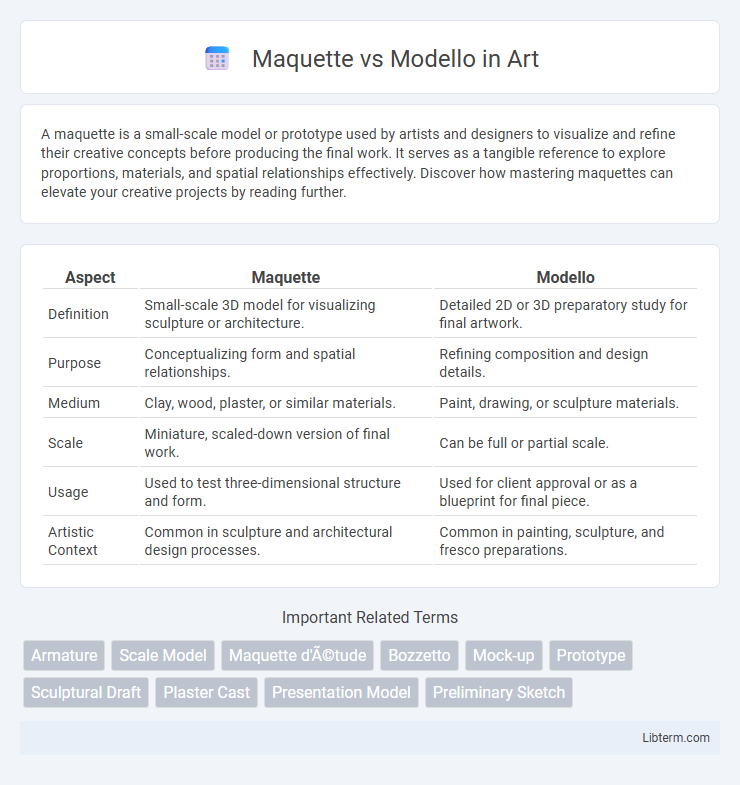A maquette is a small-scale model or prototype used by artists and designers to visualize and refine their creative concepts before producing the final work. It serves as a tangible reference to explore proportions, materials, and spatial relationships effectively. Discover how mastering maquettes can elevate your creative projects by reading further.
Table of Comparison
| Aspect | Maquette | Modello |
|---|---|---|
| Definition | Small-scale 3D model for visualizing sculpture or architecture. | Detailed 2D or 3D preparatory study for final artwork. |
| Purpose | Conceptualizing form and spatial relationships. | Refining composition and design details. |
| Medium | Clay, wood, plaster, or similar materials. | Paint, drawing, or sculpture materials. |
| Scale | Miniature, scaled-down version of final work. | Can be full or partial scale. |
| Usage | Used to test three-dimensional structure and form. | Used for client approval or as a blueprint for final piece. |
| Artistic Context | Common in sculpture and architectural design processes. | Common in painting, sculpture, and fresco preparations. |
Defining Maquette and Modello
A maquette is a small-scale, three-dimensional model used by artists and sculptors to visualize and plan a larger work before final execution, emphasizing form and composition. A modello, on the other hand, is a detailed preparatory painting or drawing serving as a guide for the final artwork, highlighting color, lighting, and intricate design elements. Both tools are essential in the creative process, allowing refinement of ideas and ensuring accuracy in the final piece.
Historical Origins of Maquette and Modello
Maquettes originated during the Renaissance as small-scale models used by sculptors and architects to visualize and refine their designs before full-scale production. Modelli, derived from the Italian word for "models," were typically detailed preparatory paintings or prototypes serving as guides for large artworks or architectural projects. Both maquette and modello played crucial roles in art history, with maquettes emphasizing three-dimensional form and modelli focusing on two-dimensional design planning.
Purpose and Function in Art and Architecture
Maquette serves as a small-scale preliminary model primarily used in sculpture and architecture to visualize design concepts and spatial relationships before full-scale production. Modello, often more detailed and refined, functions as a presentation model or preparatory study intended to communicate the finished composition to patrons or collaborators. Both tools facilitate design development but differ in scale, detail, and audience engagement within artistic and architectural processes.
Key Differences Between Maquette and Modello
Maquette refers to a small-scale, three-dimensional model used to study and visualize a sculpture or architectural concept, emphasizing spatial form and volume. Modello is a detailed, often two-dimensional preparatory drawing or painting that serves as a design blueprint for larger works, highlighting composition and color. Key differences include maquettes being physical and tactile for evaluating structural aspects, whereas modelli are visual plans focusing on design elements and presentation before final execution.
Materials Commonly Used in Maquettes and Modelli
Maquettes are typically crafted from materials like clay, foam, wire, and plaster for easy manipulation and quick prototyping, enabling artists and designers to explore three-dimensional forms efficiently. Modelli, often more refined and detailed, are commonly made from wood, metal, or high-quality paper to serve as precise scale models for architectural projects or complex sculptures. Both serve critical roles in the creative process by providing tangible references, but their material choices reflect their distinct stages of design development and level of detail.
Techniques Involved: Maquette vs Modello
Maquette techniques involve crafting small-scale, three-dimensional models using materials like clay, wax, or foam to explore spatial form and volume, offering tactile feedback for sculptors and designers. Modello techniques emphasize detailed, two-dimensional preparatory drawings or paintings, often in mixed media such as ink, watercolor, and gouache, to finalize composition, color schemes, and design elements before full-scale execution. Both methods serve as crucial steps in visualizing and refining artistic or architectural projects, with maquettes focusing on physical form and modellos on visual detail and arrangement.
Famous Examples in Art History
Maquettes and modellos serve distinct roles in art history, exemplified by Michelangelo's maquettes that refined sculptural concepts before he carved David, while Leonardo da Vinci's modellos offered detailed preparatory sketches for The Last Supper. Maquettes often provided three-dimensional insight into form and composition, as seen in Auguste Rodin's maquettes for The Thinker sculpture. Modellos, such as Raphael's detailed oil sketches for The School of Athens, allowed precise planning of complex arrangements, highlighting their importance in Renaissance art preparation.
Role in the Creative Process
Maquettes serve as small-scale, three-dimensional preliminary models that help artists and designers visualize composition, volume, and spatial relationships early in the creative process. Modellos are more refined, often detailed drawings or paintings that provide a polished representation of the final work, guiding further development and client approval. Together, maquettes and modellos function as essential tools for iterative design, enabling adjustments before the final piece is executed.
Contemporary Uses and Innovations
In contemporary art and design, maquettes serve as detailed three-dimensional models primarily used for large-scale sculptures, allowing artists to experiment with form, scale, and spatial relationships before final production. Modelli, often smaller and more refined, function as precise preparatory works that emphasize compositional details and color schemes, frequently utilized in painting and architectural projects to convey initial concepts to clients or collaborators. Innovations such as 3D printing and digital rendering have enhanced both maquettes and modelli, enabling more accurate simulations and rapid prototyping that bridge traditional craftsmanship with modern technology.
Choosing Between Maquette and Modello
Choosing between a maquette and a modello depends on the project's scale and detail requirements; a maquette typically offers a three-dimensional miniature for spatial visualization, while a modello serves as a detailed, often two-dimensional preliminary design. Maquettes excel in sculptural and architectural contexts where form and volume need exploration, whereas modelli are preferred in painting and fresco preparation for color and compositional studies. Assessing the intended use, level of detail, and medium ensures selecting the appropriate model to optimize design communication and refinement.
Maquette Infographic

 libterm.com
libterm.com